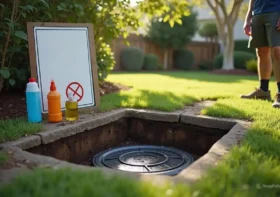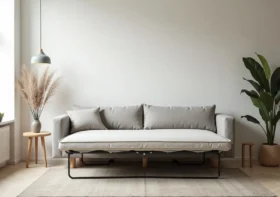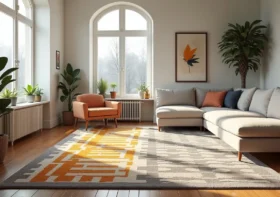6 Storage Ideas That Help You Design a Clutter-Free Environment

Creating a clutter-free space is not just about tossing out what you don’t need, it’s about designing an environment that works for your lifestyle and offers room to breathe, move, and focus. The presence of clutter can affect your mental clarity, hinder productivity, and make even the most beautiful spaces feel chaotic.
Fortunately, smart storage solutions can dramatically improve how your space functions, looks, and feels. Below are six practical storage ideas that go beyond surface-level tidying to help you build an organized, efficient, and inviting home or workspace.
Contents
- 1 Offload Infrequently Used Items to External Storage
- 2 Embrace Multi-Functional Furniture for Dual-Purpose Living
- 3 Go Vertical to Maximize Wall and Air Space
- 4 Rotate and Contain with Clear Bins and Labels
- 5 Create Dedicated Drop Zones to Minimize Daily Clutter
- 6 Digitize What You Can to Cut Down on Paper Waste
Offload Infrequently Used Items to External Storage
One of the biggest hurdles to achieving a clean and organized environment is finding room for items that are important but rarely used. Holiday decorations, old photo albums, seasonal sports gear, or inherited furniture can quickly consume closets, garages, and spare rooms.
Rather than allowing these belongings to crowd your daily living areas, consider moving them into a secure off-site facility. Whether it’s KeepSafe Storage or another facility, finding a reliable and climate-controlled space gives you the freedom to reclaim square footage at home without having to part with sentimental or seasonal items. This external approach lets you maintain a minimalist interior while still having access to the things that matter.
Embrace Multi-Functional Furniture for Dual-Purpose Living
In small spaces or homes without dedicated storage rooms, furniture that pulls double duty is crucial. Look for ottomans that open up to reveal compartments, beds with drawers underneath, or benches with hidden cubbies. These pieces serve their primary function while providing a stealthy place to store blankets, books, or electronics.
Coffee tables with lift-up tops, sofa arm organizers, and nightstands with built-in charging and filing slots can help corral the daily clutter that accumulates in common areas. When each item of furniture serves more than one purpose, you reduce the need for excess furnishings and keep things tidy without sacrificing comfort or utility.
Go Vertical to Maximize Wall and Air Space
When floor space is limited, going vertical is one of the most effective strategies for staying organized. Tall bookcases, wall-mounted cabinets, floating shelves, and hanging racks all take advantage of wall real estate that often goes underutilized.
In the kitchen, magnetic strips can hold knives or spice jars. In bedrooms, wall pegs and hooks can store accessories or handbags. Bathrooms benefit from over-the-toilet shelving and towel ladders, while garages and workshops can use pegboards to hang tools in neat rows.
Rotate and Contain with Clear Bins and Labels
Storage isn’t just about finding places to hide things, it’s about creating systems that are easy to maintain. Clear plastic bins allow you to quickly see what’s inside without rummaging through boxes or reopening containers. Pair them with waterproof labels or removable tags so you can rotate their contents by season or category.
Grouping similar items together in labeled bins, such as “winter accessories,” “electronics cords,” or “craft supplies”, adds efficiency to everyday tasks and makes cleanup a breeze. Stackable bins help use vertical space inside closets and cabinets, making the most of every inch.
Closet organizers with compartments for shoes, scarves, and folded sweaters can provide quick-grab access while keeping your wardrobe orderly.
Create Dedicated Drop Zones to Minimize Daily Clutter
One of the biggest sources of mess is the daily influx of things: keys, wallets, bags, mail, and shoes. Without a designated space for each item, these essentials tend to scatter across countertops, entryway tables, and chairs.
Drop zones act as mini organization stations, placed near entrances, in mudrooms, or close to high-traffic areas. A small shelf with a tray for keys, wall hooks for jackets and bags, and a basket for incoming mail keeps everything in check.
Adding a drawer for masks, chargers, or sunglasses turns a chaotic entry point into a smooth transition area, helping everyone in the household get out the door faster while reducing clutter in main living areas.
Digitize What You Can to Cut Down on Paper Waste
Physical clutter isn’t just about stuff, it’s often paper-based. Bills, receipts, instruction manuals, kids’ artwork, and warranties tend to pile up in drawers or on desks. By digitizing documents and storing them in well-organized cloud folders, you reduce physical clutter and gain better control over your information.
Use apps or scanners to create digital copies of important documents. Establish folders labeled by category, home, health, taxes, education, and ensure regular backups. For items you want to keep in physical form, such as certificates or cards, consider scanning them for archival purposes while storing the originals in slim, labeled file folders.
Designing a clutter-free environment is about making thoughtful choices, not just aggressive purging. The goal isn’t to strip your space bare, but to create a setting that supports the life you want to live. Every drawer, shelf, and storage unit becomes part of a system that simplifies your day, reduces visual noise, and creates room to breathe.
By integrating external storage, using multifunctional furniture, utilizing wall space, and developing smart container systems, you’ll transform your home or workspace into a place of function, focus, and calm. Whether you’re organizing a small apartment, a busy office, or a growing family home, the right storage strategies make all the difference.



